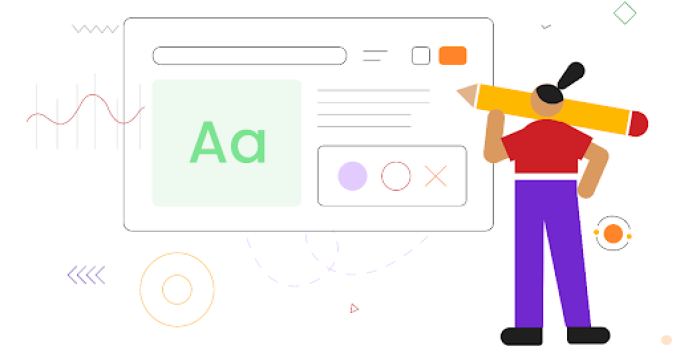In the ever-evolving world of technology and digital experiences, user interface (UI) and user experience (UX) design have emerged as critical components of success. UI/UX design courses have gained significant importance in preparing professionals to meet the demands of today’s digital landscape.
In this article, we will explore the reasons why UI/UX design courses are essential in today’s digital world, the impact they have on product development, and how they shape the career trajectories of individuals in the field.
Table of Contents
The Digital Revolution and the Role of UI/UX Design
The digital landscape has undergone a dramatic transformation over the past few decades. From the early days of the internet to the proliferation of smartphones, apps, and websites, our interactions with technology have become an integral part of our daily lives.
As a result, the way we design and experience these digital products has become a critical factor in their success.
UI design focuses on the visual elements and interactive aspects of a digital interface. It is concerned with the look and feel of an application, website, or software, ensuring that it is visually appealing and user-friendly.
UX design, on the other hand, focuses on the overall user experience, encompassing factors like usability, accessibility, and user satisfaction. A successful UI/UX design can significantly impact the way users perceive and interact with a product.
With the growing importance of digital platforms, companies are constantly seeking to improve their online presence and user engagement.
This has led to an increased demand for skilled UI/UX designers who can create meaningful and effective digital experiences. As a result, UI/UX design courses have become a crucial resource for those looking to enter this field.
The Skill Set Developed in UI/UX Design Courses
UI/UX design courses offer a structured curriculum that equips students with a diverse range of skills. Let’s explore some of the essential skills that are honed through these courses:
-
User-Centered Design:
UI/UX design courses emphasize the importance of designing with the user in mind. This means considering user needs, preferences, and behaviors to create interfaces that are intuitive and user-friendly.
-
Visual Design:
Students learn the principles of graphic design, including color theory, typography, and layout. These skills enable designers to create aesthetically pleasing interfaces that resonate with users.
-
Information Architecture:
Understanding how to structure and organize information is crucial for creating logical and efficient user interfaces. UI/UX courses teach students how to create effective information hierarchies.
-
Prototyping and Wireframing:
Students learn to create prototypes and wireframes to test and iterate on design concepts before implementation. This iterative approach is essential for refining the user experience.
-
Usability Testing:
UI/UX design courses introduce students to the practice of usability testing, where they learn to gather feedback from real users to identify and address usability issues.
-
Mobile and Responsive Design:
With the increasing use of mobile devices, courses teach students how to design interfaces that work seamlessly across various screen sizes and resolutions.
-
Accessibility:
Accessibility is a critical aspect of modern UI/UX design. Courses often cover how to design with inclusivity in mind, making digital experiences accessible to a wide range of users, including those with disabilities.
Bridging the Gap Between Design and Development
UI/UX design courses not only focus on design principles but also help bridge the gap between designers and developers.
In today’s agile and collaborative work environments, effective communication and collaboration between these two groups are essential. Designers need to understand the technical limitations and possibilities of their designs, while developers benefit from grasping the design objectives and user-centric goals.
Courses often cover basic coding and development concepts, which enable designers to better communicate with developers.
This alignment between design and development teams can lead to more efficient and successful product development processes.
The Impact on Product Development
UI/UX design courses have a profound impact on the way products are developed and brought to market. Here’s how they influence the product development process:
-
User-Centric Design:
UI/UX designers, armed with the skills learned in these courses, prioritize the user’s needs and expectations. They ensure that products are designed with the end-users in mind, resulting in interfaces that are intuitive and enjoyable to use.
-
Reduced Development Costs:
By catching design issues early through prototyping and usability testing, UI/UX design courses contribute to cost savings in the development process. Fixing problems in the design phase is far less expensive than addressing them post-development.
-
Faster Time to Market:
UI/UX designers who have undergone comprehensive training can work more efficiently, resulting in quicker product development cycles. This speed is a competitive advantage in the fast-paced digital landscape.
-
Improved User Satisfaction:
A well-designed product is more likely to meet user expectations, resulting in higher user satisfaction. Satisfied users are more likely to remain loyal and recommend the product to others.
-
Competitive Edge:
In a crowded digital marketplace, companies that invest in skilled UI/UX designers often gain a competitive edge. A well-designed product stands out and attracts users.
Career Opportunities in UI/UX Design
The demand for UI/UX designers has surged in recent years, and this trend is likely to continue. UI/UX design courses not only equip individuals with the necessary skills but also open doors to various career opportunities in the field.
-
UI/UX Designer:
The most straightforward career path for UI/UX design course graduates is to become UI/UX designers. They work on creating interfaces for websites, apps, software, and other digital products.
-
Interaction Designer:
Interaction designers focus on how users interact with a product. They design the flow and behavior of user interfaces to ensure a seamless experience.
-
UX Researcher:
UX researchers gather and analyze user data to inform design decisions. They conduct user studies, interviews, and surveys to understand user behaviors and preferences.
-
Information Architect:
Information architects are responsible for structuring and organizing content and information in a way that is easy for users to navigate and understand.
-
Usability Analyst:
Usability analysts assess the usability of digital products and provide recommendations for improvement based on user testing and feedback.
-
UX Writer:
UX writers specialize in creating clear and concise content within the user interface, including labels, instructions, and error messages, to enhance the user experience.
-
Product Manager:
UI/UX design course graduates are also well-suited for roles in product management, where they can use their design skills to shape the direction and features of digital products.
The Evolving Landscape of UI/UX Design
UI/UX design is a field that continues to evolve rapidly, and UI/UX design courses are quick to adapt to these changes. Here are some ways in which the field is evolving:
-
Voice and Conversational Interfaces:
With the rise of voice-activated devices and chatbots, UI/UX designers are exploring new challenges and opportunities in designing for conversational interfaces.
-
Virtual Reality (VR) and Augmented Reality (AR):
UI/UX designers are entering the exciting realm of VR and AR, where they design immersive and interactive experiences.
-
Inclusive and Accessible Design:
As awareness of accessibility issues grows, UI/UX designers are incorporating inclusive design principles to ensure that digital products are accessible to users with disabilities.
Conclusion
In conclusion, the importance of UI/UX design courses in today’s digital landscape cannot be overstated. They empower individuals to become skilled designers and play a crucial role in the success of digital products and the overall user experience.
As the digital landscape continues to evolve, the demand for proficient UI/UX designers will only grow, making UI/UX design courses a valuable investment in one’s career and a driving force behind innovation in the digital world.




